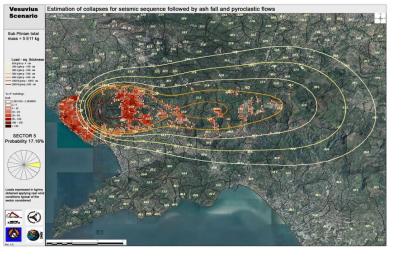Natural phenomena such as earthquakes, mud floods, landslides, volcanic eruption or industrial accidents may cause huge disasters. Each crisis generally determines consequences in multiple sectors and systems (e.g. building and infrastructures, roads and public transport, lifelines and telecommunication, society and emergency management.) that are singularly affected by the triggering event, but also may be hit by effects following the main one, the so-called “cascading effects.”
Therefore, the methodological approach to the risk analysis of a single event made by the classical probabilistic convolution of Hazard, Vulnerability and Exposure has to be appropriately modified. The volcanic hazard represents a relevant research issue in the field of multi-risk assessment and management, as it embodies a possible well-defined sequence of disastrous events (i.e. a Sub-Plinian event is characterized by the following phases: several seismic tremors and earthquakes during the unrest phase, ash fall, bombs and gas emission during the eruption, pyroclastic flows at the end of the eruption and lahars after the eruption), which in turn can lead to cascading effects in multiple systems.
An effective Disaster Operations Management (DOM) tool and its support to decision-makers should then be focused on a dynamic evolution of the risk, in order to minimize the physical and economic losses, especially in the case of Low probability of Occurrence of main event (LO) and High socio economic Impact (HI) of the expected losses. In this case, the effect of long-term mitigation strategies, as well as short-term recovery sub-plans, depending on existing capabilities and on their possible altered availability during the event, should be fully evaluated with a decision management perspective. In this sense a crucial aspect of the dynamic predictive model is the time-dependant vulnerability curves able to estimate the cumulative damage of the considered element at risk by combining the actions of a sequence (seismic crisis) or of the contemporaneity of events (earthquakes with ash on the roofs).

